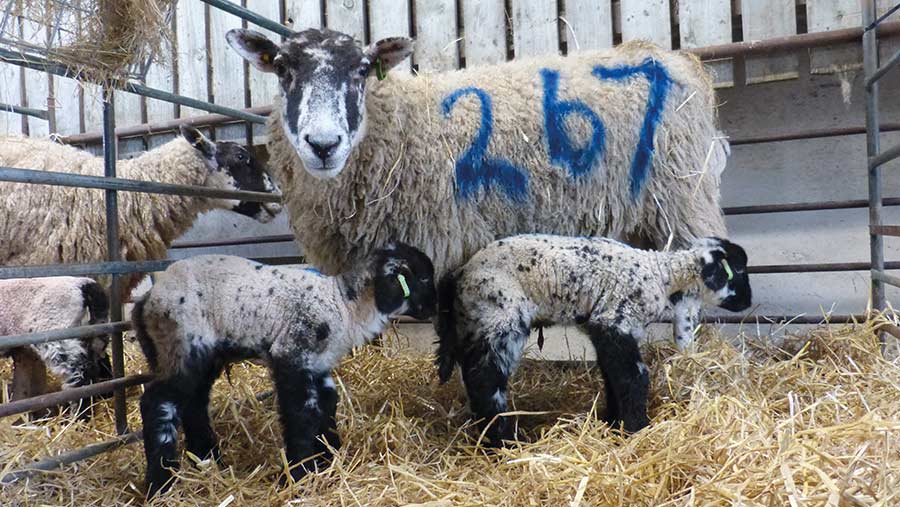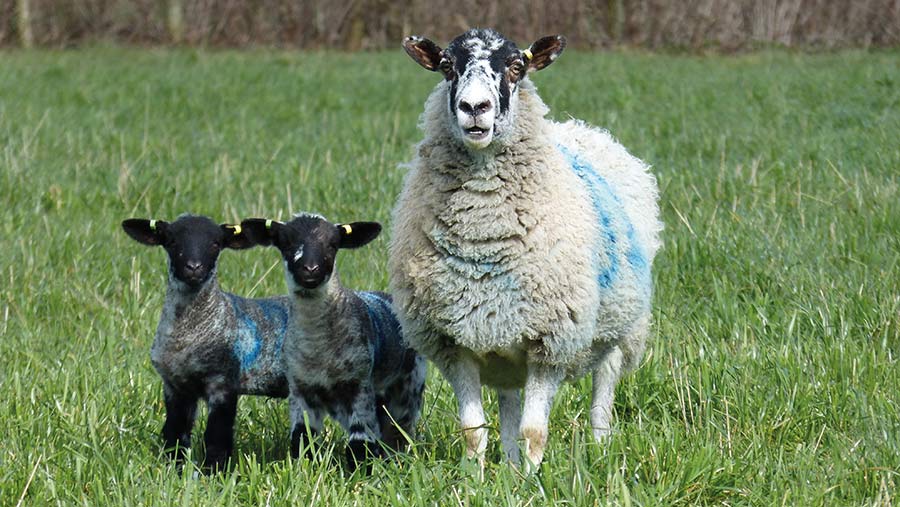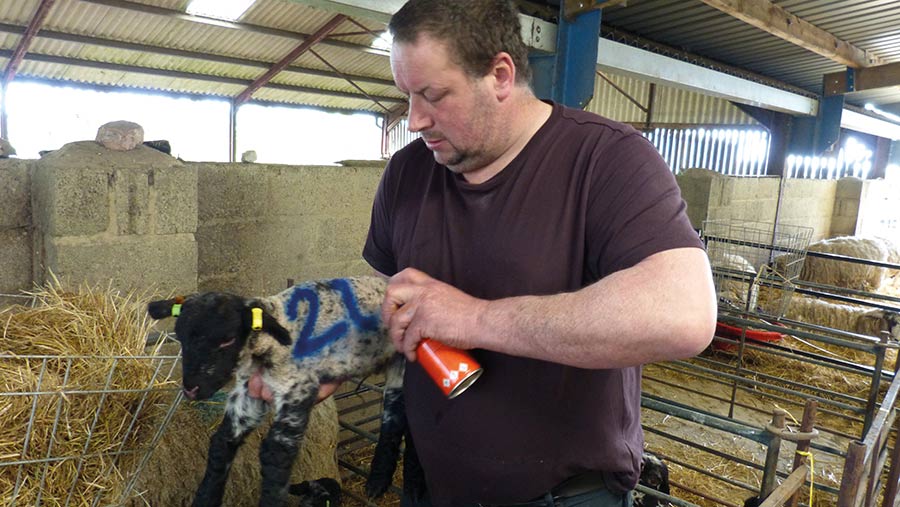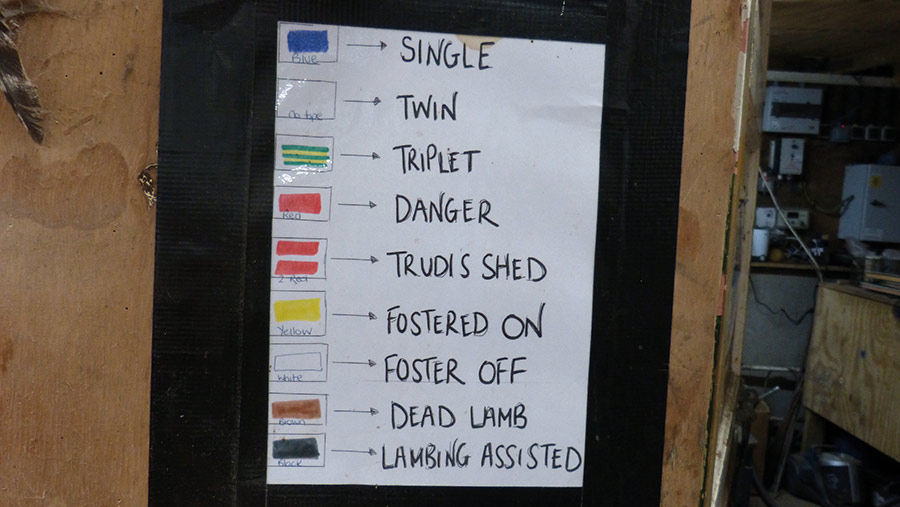Video: How farmer lambs 1,000 ewes inside without oral antibiotics
 © MAG/Michael Priestley
© MAG/Michael Priestley Diligence around lambing shed hygiene and ewe body condition scoring have allowed a Wiltshire flock to get through four lambings without a single dose of oral antibiotics.
Martin Tobutt and the team at the Biddesden Farm Partnership, near Andover, Wiltshire, last dosed a lamb with spectinomycin to control E coli and watery mouth in 2018.
This is a major achievement, as the system previously employed a blanket oral-dosing policy for every lamb. Now the focus is on body condition, shed hygiene and colostrum.
See also: How oral dosing was cut by 70% in high-input flock
Watch the video and read the full report below.
Flock facts

Suffolk cross Mule lambs © MAG/Michael Priestley
- 1,000 North of England Mule ewes lamb in March
- 200 Mule lambs lamb in May
- Sells about 300 Suffolk cross Mule ewe lambs annually
- Cull ewes and prime lambs sold at Frome or Thame
- 52ha (130 acres) silage leys
- 60-80ha (150-200 acres) permanent pasture
- Flock runs alongside pedigree Ayrshire herd and 810ha (2,000 acres) of arable
Low antibiotics use
The flock’s antibiotics use was 2.23mg/kg PCU (population corrected unit) last year. The farm’s vet, Emily Gascoigne of Synergy Farm Health, did the calculation.
She says this is about one-fifth of the industry average and puts the flock in the top 25% of Synergy’s sheep clients. Just six lambs were injected with amoxicillin this year.

Martin Tobutt © MAG/Michael Priestley
Mr Tobutt has been head shepherd at Biddesden since 1992. Even with all his experience, he admits cutting out Spectam was “a leap of faith”.
Until its withdrawal in January, Spectam was the only licensed antibiotic for treating watery mouth.
“Pressure from the vets helped us change, and I think deep down we knew we were using too much,” he says. “
As sheep farmers, we aren’t big antibiotics users, but at lambing time and in managing lameness we have relied on antibiotics in the past.
“Emily became our vet and she suggested we change. We started vaccinating for foot-rot and using flock data and electronic identification (EID) to track antibiotics and other treatments.
“The challenge now is to reduce antibiotics further – but I don’t mind a challenge.”
Housing
Lambing takes place in a purpose-built shed at Biddesden. It has Yorkshire boarding, which helps ventilate the ewes, and a capped vent along the roof with a fan at the one end.
This can be used to drive stale air out of the shed on still days.
The flock is run alongside a large arable unit, so ample amounts of straw keep ewes and lambs clean and reduce incidence of scald in the shed, explains Mr Tobutt.
Straw is bought from the arable unit at the market rate each year.
Barn layout helps drive feed intakes when ewes are loose-housed. They have hay racks and a concrete central passage to ensure ample feed access to ad-lib hay and the cake ration.
Blood profile testing
However, the big change was a pre-lambing metabolic blood profile to test ewe energy levels before lambing. Previously, the farm just relied on body condition scoring.
“This was the big thing we changed when we were challenged to cut Spectam out,” explains Mr Tobutt. “If condition is right, colostrum is right and that’s the key to getting lambs up and about without Spectam.”
Ewe condition is checked alongside a blood report from the lab, which Miss Gascoigne uses to suggest ration changes.
Concentrate feed can be adjusted in the last three or four weeks of pregnancy if energy and protein levels are low or if ewes are overconditioned.
How Biddesden lambs without oral antibiotics
Focus on the ewe at weaning
- Grow lambs fast and wean all ewes by 100 days. This is achieved by integrating grassland management with the dairy unit. First-cut is typically clamped for the cows, second-cut is baled as haylage and the aftermaths are grazed for finishing lambs
- This gives ewes time to regain condition as dry sheep before wintering. Suffolk tups are used to hit high growth rates. Lambs can motor and grow up to 800g/day, with 400-500g/day commonplace
- Sheep are body condition-scored to inform grazing decisions, and again at pre-tupping to sort into tupping groups
Get sheep in good condition
- Ewes are condition-scored on to winter crops. Last winter 60ha (150 acres) of turnips and 36.5ha (90 acres) of phacelia, swede and fodder radish were grown
- Metabolic profiles were done on six twin-bearing sheep, six triplet-bearing sheep and six ewe lambs to ensure protein levels were optimal, about a month before the start of lambing in March
Ensure colostrum is there and accessible
- Every ewe is checked for milk. If there isn’t enough colostrum to fill the lamb, colostrum is supplemented with powder or cow colostrum from the Ayrshire herd – about 125 litres was frozen in takeaway tubs and used last year
- Triplets will typically get topped up regardless of the ewe’s milk
- Ewes are crutched and belly-sheared before housing to keep them clean, to ensure teats are accessible and to avoid wool sucking
Pre-lambing vet training
- The flock vet delivers a pre-lambing training session so all farm staff understand best practice. The session can last an hour or two
- The session covers housing and feeding ewes, lambing, suckling, and rearing lambs, and preventing/dealing with all the potential issues that could arise
Communication and fostering

What the tape means © MAG/Michael Priestley
- Tape is used on pens to direct staff and make sure all lambs that require help are fed and attended to (see picture)
- As many lambs as possible are fostered on to ensure ewes have twins at foot at grass. Numbers of pet lambs are minimised
- All lambs’ navels are double-dipped in iodine
Hygiene
- Ewes and lambs are moved outside, weather permitting, 24 hours after birth
- Tape is removed from the gate and the pen is mucked out down to the concrete floor and brushed
- A disinfectant powder is used to kill any pathogens and the pen is left for as long as possible before the next ewe enters
- Hot water is on tap in the lambing shed and every bottle is kept sterile in a stainless steel sink and worktop
Perpetual watery mouth could be a sign of a bigger problem
“Farmers don’t use antibiotics because they are excited about the products, I think they see them as doing everything possible and being diligent to keep lambs alive and healthy.
“But if we are not careful, we could mask bigger problems for the future, such as poor performance or medicines ceasing to work.
“Lambing shed hygiene and routine, colostrum quality and nutrition are all important, but if farms want to cut back on antibiotics, I think it starts at weaning.
“Making sure all ewes recover their condition and head into winter in good condition is important.
“If a sheep business is using antibiotics for a perpetual watery mouth problem, there is probably something else that is wrong and needs sorting out, which will have broader benefits on the business, sheep and shepherd.”
Emily Gascoigne, specialist sheep vet and farm vet champion trained in antimicrobial stewardship, Synergy Farm Health
